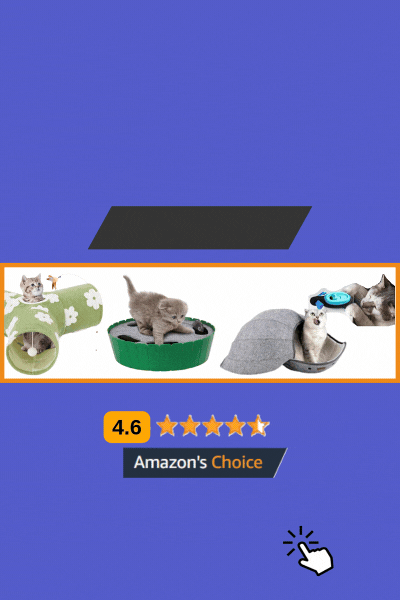While kneading can sometimes be cute, it can also be a call for attention.
Mostly, this kind of behavior is deeply rooted in feline instincts.
Sometimes it can be based on emotions as well.
Thus, we need to pay closer attention to their behavior and understand why they behave the way they do.
Keeping all that in mind, we bring to you a well researched and concocted article to help you understand your cat better.
1. A Comforting Instinct from Kittenhood
Cats start kneading from the time they are newborns. As kittens, they knead their mother’s belly while nursing, stimulating milk flow and bonding with her through touch and scent. This act becomes associated with feelings of warmth, nourishment, and safety.
Even after they’ve grown up, cats often continue kneading as a way to re-create that sense of comfort. When your cat kneads you, especially while purring and snuggling, it’s a strong indicator that they see you as a source of security and contentment. You’re essentially their stand-in for “mom.”
2. Marking You as Their Territory
Cats are very scent-oriented animals, and they have scent glands located in the pads of their paws. When they knead, these glands release pheromones—a kind of invisible signature.
By kneading you, your cat is essentially saying, “This human is mine.” It’s a way of claiming you as part of their territory, much like how they might rub their face on your leg or tail around your ankles. This behavior is especially common in multi-pet households where your cat may feel the need to reaffirm their bond or stake their claim.
See Also:
3. Expressing Love and Affection
Kneading is often a physical expression of love. Cats can’t exactly hug or kiss, so this is one of their go-to ways to show affection. If your cat climbs into your lap, settles in with soft eyes, begins to purr, and starts kneading, take it as a loving gesture.
It’s their way of saying “I trust you,” and “You make me feel safe.” These moments usually occur when your cat is feeling totally relaxed and happy in your presence. It’s a form of bonding—similar to grooming each other in the wild.
4. Preparing a Comfortable Resting Spot
In the wild, cats would knead grass, dirt, or foliage to create a soft, comfortable nest to rest or give birth. Though domestic cats now enjoy cushions, couches, and beds, the instinct to knead before lying down remains deeply ingrained.
That’s why you might see your cat kneading a blanket, your belly, or even your laundry pile. They’re mimicking the behavior of their ancestors, ensuring their “nest” is soft, safe, and ready for a nap.
5. Stretching and Flexing Their Muscles
Kneading serves a practical purpose too—it’s a natural form of stretching. Each paw motion allows your cat to flex their toes, legs, and shoulders. This helps keep their muscles supple and their joints mobile.
Cats often knead when they’re transitioning from rest to activity or vice versa, just like how we stretch when we wake up or sit too long. It may be part of their daily stretching routine to stay limber and relaxed.
6. Stress Relief and Self-Soothing Behavior
Kneading can act as a coping mechanism for anxious or stressed cats. The rhythmic movement can help them self-soothe, especially when they’re in an unfamiliar environment or feeling unsettled. This is similar to how humans might fidget or play with their hair when nervous.
If your cat tends to knead more when there are loud noises, guests in the house, or changes in routine, it could be their way of calming down. The act releases endorphins, which help them feel emotionally balanced and safe.
7. Mating Behavior in Unspayed Females
In unspayed female cats, kneading can be linked to mating instincts. When in heat, a female cat may knead more frequently, especially if accompanied by restlessness, yowling, rolling on the floor, or lifting her hindquarters.
While kneading alone doesn’t confirm she’s in heat, when it occurs alongside these signs, it’s likely tied to her reproductive cycle. If this is the case, spaying will usually reduce or eliminate this behavior over time.
8. A Habitual or Learned Behavior
Sometimes, cats knead simply because they always have—and it feels good. If kneading was never discouraged and was often met with affection or petting, it can become a learned behavior that persists.
This is more likely in cats who were bottle-fed or separated from their mothers early on. Kneading may become their default way to express comfort or bond with their humans.
9. Enjoying the Texture Beneath Their Paws
Cats are tactile creatures. They’re drawn to textures that feel pleasing under their paws. Blankets, sweaters, or your soft hoodie might trigger a kneading response simply because they’re cozy and luxurious to touch.
If you notice your cat only kneads on certain fabrics—or avoids kneading you directly—it may have more to do with material preference than emotional messaging.
10. Dreaming of Kittenhood
Cats often knead right before falling asleep, especially when they’re curled up in a warm spot. Some experts believe that kneading helps cats mentally return to a time of security, when they were kittens nursing.
In this way, kneading might be a feline version of nostalgia—an unconscious behavior that helps them drift peacefully into rest, surrounded by good memories and comfort.
Well, we hope that now you know why your cat has been spending a lot of time on blankets and laps.
Hope you find the article informative and helpful.

Nikita Rout is a passionate content writer at HowItSee.com, where she explores the wonders of animals, nature, and the curious questions that spark our imagination. With a love for research and a knack for simplifying complex topics, she brings clarity and creativity to every article she writes. When she’s not writing, you’ll likely find her reading about animal behavior or coming up with unique pet name ideas.

